

Every Defeat, an Opportunity: The Silver Lining in NEWR Denver’s Failure and The Future of DDSA’s Housing Justice Committee
ISSUE #2
By Alex Yukhananov
There was a sense of cautious optimism at Tom’s Starlight among NEWR (No Eviction Without Representation) volunteers. It was a mild night in Denver, and volunteers from Initiated Ordinances 305, 306, and 307 came together for an election night party. Future political hopefuls were politely and awkwardly shilling, volunteers were huddled over phones, and newcomers were just happy to be there. A free drink can set a tone.
Talking to fellow volunteers at the party, I gleaned a hopeful yet nervous certainty. Some volunteers felt that Initiated Ordinance 305 would pass with a sizable margin, however, there were a few notable hold outs. NEWR veterans Robert Adams and Ryan Rasmussen tempered their expectations. Their enthusiasm was quelled by the conversations they had with everyday voters. They knew predictions meant little in the face of $528,246.96 in opposition spending, while NEWR, the organizing force behind Initiated Ordinance 305, spent $141,463.54. They knew how the opposition defined the narrative and how it impacted everyday voters. I was hopeful it would pass, perhaps too hopeful. We all were.
At 7 PM on November 8th with 23.7 per cent of the votes counted, 39.68 per cent for and 60.32 per cent against Initiated Ordinance 305. The official result came on November 21st, 42.51 per cent for and 57.49 per cent against Initiated Ordinance 305. It was a devastating loss; however, every failure has the potential to blossom into something greater. The long and rich history and tradition of economic justice movements informs us that we will fail more often than we win, but when we win, we shift the needle ever so slightly toward a more just and fair world. NEWR sparked a chapter in Denver Democratic Socialists of America (DDSA) Housing Justice Committee (HJC) and brought about new opportunities and avenues for the HJC.
Four months after the November 2022 election, I contacted Robert Adams and Ryan Rasmussen to understand how NEWR formed, NEWR’s struggles and successes, how NEWR shaped DDSA’s Housing Justice Committee, and how NEWR shaped their activism.
In early 2020, members of the HJC helped organize a building in East Denver. “We made pretty good progress. We made news, held meetings, and the tenants were ready to submit a petition to the property managers, but then COVID-19 hit,” said Rasmussen. “The fight went from organizing tenants to how am I going to pay for my apartment.” He noted that the eviction moratorium did not go into effect immediately. The CDC’s moratorium began on September 4th, 2020, nearly six months after Colorado’s first batch of recorded COVID-19 cases.
Shifting from tenant organizing to providing assistance to tenants facing eviction, the HJC began tracking evictions using a web scraper maintained by Rasmussen. “We started scraping eviction cases from the court’s docket and reached out to tenants directly,” said Rasmussen. In 2020 and 2021, there were 2,912 and 4,894 eviction filings in Denver County respectively, a relative decrease from preceding years due to increased government assistance and enacting the eviction moratorium. Even with this decrease, effectively mitigating evictions in Denver was a monumental task. It was far from sustainable and something needed to change.
In late 2020, two developments would nudge members of the HJC to adopt NEWR in Denver and to ultimately embark on a proactive electoral strategy. The first development occurred on November 3rd, 2020 in Boulder. Voters in Boulder approved Ballot Issue 2B, providing legal representation to tenants facing eviction, by a large margin. The measure passed with 58.61 per cent of the vote and established Ordinance No. 8412. Ordinance No. 8412, or No Eviction Without Representation, mandates the city of Boulder to “establish, run and fully fund a program to provide legal representation to tenants who face the loss of housing in eviction and administrative proceedings” and “provide rental assistance for persons that are vulnerable to eviction.” Additionally, it creates a tenant’s committee comprising of five members. It’s funded by a $75 per year license fee on rental dwelling units, resulting in an estimated $1.9 million per year for the program.
The second development happened on December 1st, 2020, when HB 20-1009 went into effect. HB 20-1009 requires Colorado courts to suppress eviction records while in legal proceedings and to continue suppressing these records if the tenant wins. This law partially combats tenant blacklisting, an insidious practice used by landlords and property managers to leverage housing court records against prospective tenants and using these records as a pretext to deny rental applications.
HB 20-1009 hindered HJC’s eviction outreach capabilities. NEWR passing in Boulder however, was an example of what is possible. Adopting a NEWR-like campaign was the next logical step in the HJC’s evolution. It was HJC shifting from retail, door-to-door eviction mitigation, to wholesale and city-wide systematic reform.
“We had to learn how to put a measure on the ballot, we had to start from the basics,” said Rasmussen. Learning on the spot, Rasmussen and other HJC members sought professional guidance. They consulted and worked with Mike McCorkle, a lawyer and a fellow Denver DSA member. They learned how to properly operate a campaign in Denver, manage finances, gather signatures, meet critical deadlines, mobilize, and organize.
In the summer of 2021, Robert Adams joined the NEWR campaign and became a member of NEWR’s three-person steering committee, serving with Mary Imgrund and Mitch Weldon. “We started as a flat hierarchy and eventually had a need for more direction.” Recognizing the power of both vertical and horizontal hierarchies, NEWR settled on something in between. However, by not fully committing to either organizational structure, the campaign at times lacked a clear division of labor. On top of that, Adams added “we also had an enormous amount of work. We had a very ambitious scope, relative to the number of people involved. In retrospect, we did a lot with the capacity we had.”
Leveraging the organizational capacity of DDSA and other organizations, NEWR superseded the number of signatures required and successfully got on the ballot for the November 2022 election. It was an enormous effort and NEWR leaned heavily on the support of over one hundred volunteers and countless small dollar donations. The ballot initiative in Denver mirrored Boulder’s Issue 2B. A key difference was increasing the number of members on the tenant committee from five to seven.
I asked Rasmussen what NEWR could have done better. “The loss margin was proof that it wasn’t one thing,” said Rasmussen. “The obvious answer is not enough organizing and more canvassing, but that’s pretty much the case for every campaign. The TABOR language and opposition spending likely did the most harm.”
Rephrasing my question to Adams, I asked if he would change anything. He shared similar sentiments to Rasmussen and added more context. “If I were to change anything, I would have reframed the ballot language to be as palatable as possible. Polling suggested voters in Denver were more likely to agree that landlords were justified.” Even though the average voter in Denver has more in common with a tenant getting evicted than a landlord carrying out the eviction, there is more of a semblance of personal responsibility in Denver. It’s more of an “if you didn’t pay rent, then you deserve it” attitude, without much consideration for the underlying causes of evictions, and not fully understanding that evictions can stem from a multitude of factors outside of non-payment exclusively. In addition to this general underlying sentiment, the opposition launched a generic “No On 305” campaign, bombarding social media with ads containing a very simple and powerful pain point for voters: rental prices can increase if this succeeds, why risk it.
Roberts added, “I think the fee likely confused some voters too.” Roberts referred to the $75 yearly fee on landlords and surmised that voters possibly confusing it for a monthly fee. More so, Denver voters may have intuited that this fee would result in an increase in rent. The initiative made no guarantees that this fee passed via increasing rental costs and renters already have little power in negotiating the cost of rent. The astronomically high cost of rent in Denver likely made tenants more sensitive to any legislation that suggested imposing a fee on landlords. Time and time again, landlords simply increase rent without a viable reason. When they have a reason to increase it, they will use it in a disproportional manner. Voters in Denver likely thought, “I know I’m not going to get evicted, why risk raising my own rent?” The open secret is, landlords can and will increase rents disproportionate to the value they add and they do it without reason. Damned if you do, damned if you don’t.
In the aftermath of NEWR, both Rasmussen and Adams echo similar takeaways from the campaign. They don’t regret doing it, and NEWR was a necessary effort that grew DDSA’s capacity and tested what the HJC was capable of. However, if they had to do it again they probably wouldn’t to that extent. Neither Rasmussen or Adams want to dedicate their time exclusively to one colossal effort again. This is an understandable sentiment, considering they spent between one to two years of their life, essentially embracing a second full time job. It is extraordinarily difficult and an uphill battle, but without NEWR and the push toward electoralism, the HJC would not be where it is now. NEWR did amazing things with the resources available, and it pushed DSA to be more active in electoral and legislative pursuits.
For example, DDSA is a part of the Colorado Homes for All (COHFA) steering committee, a working coalition made up a wide swath of organizations dedicated to guaranteeing housing as a human right in Colorado. COHFA helped craft and drive house bills 23-1115 and 23-1171. The former would lift the state ban on local control of rents and the latter would require just cause for evictions. Both bills passed their respective committees and HB23-1115 recently passed the house, with 40 representatives voting for it and 24 voting against it. This is a huge development in housing justice in Colorado, and NEWR set the HJC toward this direction.
Rasmussen and Adams both prefer working toward smaller victories and pursuing a multipronged approach to housing justice. Rather than dedicating their time to an all-or-nothing strategy, they are focusing on DDSA’s legislative efforts, working on promoting and supporting DDSA endorsed candidates, tenant organizing, continuing on growing the Housing Justice Committee, and generally building power outside of electoral politics.
~~
Alex Yukhananov is a member of the Denver DSA Steering Committee.
EDITOR’S NOTE: This article was written in spring 2023 as part of an issue on local elections and the midterms (Issue #2) which was not able to be published at the time due to capacity constraints. It is now being released from the vault.
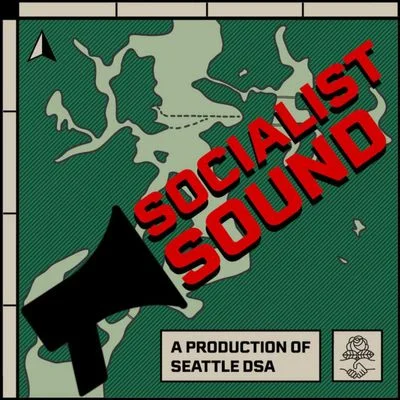

Winning Time for Socialists in Tacoma
Socialists are taking on Tacoma City Hall and winning. My four guests today are all good friends and fellow leaders of Tacoma DSA. We're in the midst of a major ballot initiative campaign to win the strongest tenant protections in Washington state, and on the cusp of winning DSA’s first seat on Tacoma City Council for Jamika Scott, a deeply-rooted Black leader and democratic socialist.
In this episode, we tell the story of how Tacoma City Council, on behalf of the landlord lobby, tried to defeat our Tenant Bill of Rights with a watered-down, competing ballot measure – and how we took them to court and won, getting their deceptive measure removed from the November ballot.
We discuss the labor movement’s strong support for our Initiative #1, the debate in labor around Jamika's campaign, and how these fights are positioning DSA to help transform Tacoma city politics in the years ahead.
Find out more about Initiative #1, the Tenant Bill of Rights, at Tacoma4All.org, and follow our campaign on Instagram, Facebook, and Twitter @Tacoma4All
Tacoma DSA endorsed candidate Jamika Scott’s website is jamikafortacoma.com
Check out The Stranger's article, “Tacoma is the Revolution,” which we reference in this episode.
Become a Monthly Sustainer of SOCIALIST SOUND
This podcast is only possible due to the generous monthly contributions of Seattle DSA members and supporters who pay my part-time salary as the chapter’s Communications Organizer. To sustain this podcast, and our wider communications work, please become a monthly contributor at seattledsa.org/podcast
Thanks to Jason Cory for editing this episode!


Electoral is a sprint; Socialism is a marathon
ISSUE #2
by Mary Imgrund
After our weekly DSA joint canvass launched, the staffers quietly typed away at our sticker-covered Macbooks while a few candidates discussed burnout, frustration, and rage on the campaign trail. When we were alone, the impromptu co-working meet became more akin to a therapy session. I smiled faintly, “I feel like I wake up every day and set myself on fire.”
Self-immolation may be necessary to get through the desperate, flailing race of election season. However, our goals as socialist organizers require more care and more intimate discussions that the race to April 4th preclude.
At our last electoral meeting, we discussed the challenges inherent to our dual-purpose goals: organizing members into electoral and up to be leaders and the immediate needs of turning out canvassers, creating graphics, setting logistics for events, doing fundraising, and everything else that needs to be done yesterday on the campaign trail.
I bemoaned my yearning for longer-term discussions about what our goals are, what socialism looks like at the municipal election, and what we can accomplish in the next 5 or 10 years. And a member brought up the core contradiction of doing this work: Electoralism is a sprint. Socialism is a marathon.
So how can we run two races at the same time with wildly different needs?
To start, the idea of contradiction is nothing new in leftist spaces.
In Mao’s treatise “On Contradiction,” written in 1937, he suggests that contradictions are what define a thing and without contradiction, a thing loses its identity. A classic Marxist interpretation of this is that the primary “contradiction” that defines every society is class struggle.
Mao continues that primary contradictions, say, capitalism, always create “secondary” contradictions, such as between imperialists and their colonies that require the “primary” contradiction, in this case, a capitalist society. These “secondary” contradictions flow downstream from the primary contradiction, but may often become more important or the most prevalent in society.
I find this to perhaps be one of the strongest points from Mao’s writing on contradictions because it makes a very clear case that in order to fight capitalism, we must strongly oppose white nationalism and christian identity movements in order to effectively struggle for the working class. Almost 60 years later, the introduction of the idea of intersectionality, originating in critical race studies, added much-needed clarity and definitions to many of these overlapping and cascading series of “contradictions,” thanks to Black feminist scholar Kimberlé Crenshaw.
In his book Contradictions of Real Socialism: The Conductor and the Conducted,
Michael Lebowitz explores the “real socialism” movement originating from 20th—century socialist societies to distinguish themselves from abstract, theoretical socialism. He finds that many of the contradictions within these “real socialism” societies, such as the separation of thinking and doing, created the conditions in which a nascent capitalist class emerged and was the source of the crises of “real socialism.”
Instead, he argues, socialists must go beyond “the hierarchy inherent in the relation of conductor and conductor to create the conditions in which people can transform themselves through their conscious cooperation and practice – a society of free and associated producers.”
Many have also written about my specific dilemma working in electoral politics. Not only are we asked to be at once the “always on” campaign staffer and the community organizer, but we’re also asked to grapple with the contradictions of electoralism itself.
We acknowledge that institutions like the City Council or the Mayor’s office are inherently bourgeois institutions that were created to uphold the will of capital; meanwhile, we must also fight like hell for every crumb and every concession we can get from these institutions. We have to run the best campaigns and play the game of professional electoral politics to be the most effective in creating the best relationships and getting the best concessions from these institutions.
We acknowledge the limitations of electoralism while working within those constraints to begin undoing frankly genocidal policies against the poor and working class as many of Denver’s current mayoral candidates promote (arrests as a response to homelessness? Are you serious?).
So, in that, I become more comfortable with the two races our committee is running right now. Many of us are sprinting. Others are on the marathon track. Most of us change which race we’re running on a daily basis. We need to phone bank and while doing so, begin imagining what the next five years of socialist electoral activism can look like. We need to knock on doors and also spend time having long and deep conversations with our comrades about what our goals and shared values are on the electoral stage.
We need to elect all of our endorsed candidates on April 4th and get right back to work on April 5th promoting bills to defend tenants with our comrades in Housing Justice, strengthening our relationships with our new electeds, decide what our legislative priorities are, and even support our neighbors in Aurora who are having their own election soon.
My legs are tired, but I’m still running. If you want to get involved, join our electoral meetings (that I promise only sometimes take over 2 hours), bi-weekly Mondays at 6pm.
~~
Mary Imgrund is the former chair of the Denver DSA Electoral Committee.
EDITOR’S NOTE: This article was written in spring 2023 as part of an issue on local elections and the midterms (Issue #2) which was not able to be published at the time due to capacity constraints. It is now being released from the vault.


Too Long Didn’t Read: A Solo Socialist Reading Club Part 2
ISSUE #2
by Erica Curtis
The goal of the Political Education Committee is to further every comrade’s ability to thoroughly articulate both what we are doing to further socialism and exactly why we are doing it. To assist in this effort, we would like to introduce a new segment of The Pike Press, in which a different book on a socialist theme will be summarized for readers’ convenient consumption. We will start where so much of education begins, with the ABCs. Edited and published by Jacobin Magazine, The ABCs of Socialism teaches the bedrock concepts of socialism through a simple question-and-answer model. You’ll hear familiar questions, learn new information, and obtain surprising answers. Let’s get ready to learn.
Question One: Isn’t America already kind of socialist?
People like to argue that America is a socialist country because its government uses tax dollars to execute collective projects to serve its citizens. Stop and consider that not all collective activity is socialist activity. The police department is a collective organization funded by taxpayer dollars, but is anyone under the delusion that the police department is there to uplift citizens and support striking comrades? The conflation of government activity with socialism is an unfortunate trend, especially when it comes to the (massive) amount of spending involved. When we consider state activity, we need to ask ourselves two basic questions:
- Does it reinforce or undermine the power of those who own capital?
- Does it increase our subordination to market discipline or offer us more freedom from its demands?
Another unfortunate reality is that the rich and powerful intend to stay that way by investing heavily in political activity that promotes the status quo. In the interest of keeping things exactly as they are, the (already elected) politicians are perfectly happy to align their policy decisions to the benefit of themselves and their wealthy donors. So, winning government power and using it to disrupt the capitalist class is the necessary first step toward beginning the transition to socialism. We would do well to remember that pretenders to socialism have come to power in the past, and for true socialism to work, the administrative and political structures of government must be thoroughly democratized in order to further the cause of human freedom. This means mass popular support for the transition, direct participation in government affairs, and a dramatic overhaul of state agencies and administrative structures. We need to begin imagining and building new institutions that support this vision of a socialist democracy.
- Answer One: No socialism isn’t just more government – it’s about democratic ownership and control.
Question 2: But at least capitalism is free and democratic, right?
In the United States, many take for granted that freedom and democracy are inextricably connected with capitalism – even renowned economist Milton Friedman argued that capitalism was a necessary condition for both. There is historical evidence pointing to the rise of capitalism and the spread of individual freedoms and political organization. So why would socialists claim that capitalism fundamentally obstructs freedom and democracy? While capitalism has promoted the emergence of certain limited forms of freedom and democracy, it imposes a low ceiling on the further realization of both – you get a taste, but not a full serving. Freedom and democracy both lay pinned to the same core value of self-determination – the idea that people should have as much control as possible over the shape their lives will take. It is nearly impossible to take an action that will impact no one but yourself, so what we need is a set of rules to distinguish between questions of freedom and questions of democracy. Currently, this boundary is set by the distinction between public and private spheres, but this construct intentionally constrains the realization of freedom and reduces the scope of democracy. We can see this apparent reality when we consider that:
- “Work or Starve” Isn’t Freedom
- Capitalists Decide
- Nine to Five is Tyranny
- Governments Have to Serve the Interests of Private Capitalists
- Elites Control the Political System
These consequences are endemic to capitalism as an economic system. While public constraints can be put in place to erode the boundary between private and public, thereby palliating these freedom-impeding features of capitalism, freedom and democracy cannot be fully realized until capitalism is not just tamed, but overcome.
- Answer Two: It might seem that way, but genuine freedom and democracy aren’t compatible with capitalism.
Question Three: Socialism sounds good in theory, but doesn’t human nature make it impossible to realize?
“Good in theory, bad in practice” is the dismissive reply we are often faced with when we try to discuss the possibility of a socialist reality. The follow up to this reply is often even darker: that capitalism is much more suited to human nature (with human nature being defined by competition and veniality). Humans are not simple creatures; we are capable of both unspeakable evils and remarkable kindnesses. As socialists we are committed to the view that we all strive for a freer and more fulfilling world because everyone, everywhere, cares about their freedom and fulfillment (this is part of human nature, too!). While resistance to exploitation and oppression are a consistent feature of our human history, mass collective action is a rarer event because of the inherent risks. However, sometimes, people do step up and take risks, and one of our principle tasks as socialists is to support these movements. To this end, we know that we will be helped, not hurt, by our shared nature.
- Answer Three: Our shared nature actually helps us build and define the values of a more just society.
Question Four: Don’t the rich deserve to keep most of their money?
When debating taxes, the conversation often leads to an argument about whether or not your iPhone would exist without the high income (and driving incentive) that goes to creators like Steve Jobs. If we tax innovators like this, won’t we all be worse off? First, we must understand what taxes are and what non-socialists think about them. Tax policy does two things in a capitalist society: resource control and allocation.
- It determines what share of the total economic pie will be managed by the public, and how much will be left to the use of private actors ( = resource control).
- It stipulates how that public share is divided up between the competing needs and wants of individuals, organizations, and corporations ( = allocation).
The socialist view of redistribution within a capitalist society must reject an important premise at play in nearly all tax policy debates: That pre-tax income is something earned solely by individual effort and possessed privately before the state intervenes to take part of it. We must realize and buy into the idea that wealth is a social product – that none of us would have any wages or resources without the work and contributions put forth by all of us. With this in mind, it makes sense that the socialist case for taxation and progressive redistribution is built from three basic factors of how capitalism works:
- Personal incomes and corporate profits are not simply the result of individual work and business competition.
- The class inequality that results from making this social product is relational.
- Redistribution through taxation is a means of extending individual freedom: both negative freedom (“freedom from”) and positive freedom (“ability to”).
Any tax policy that divides up the social product in a way that leaves some in luxury and some in destitution cannot be said to promote freedom. Progressive redistribution through taxation is both a means to redress structural inequalities and the primary way we can expand and extend freedom to as many people as possible.
- Answer Four: Wealth is socially created – redistribution just allows more people to enjoy the fruits of their labor.
Question Five: Will socialists take my Kenny Loggins records?
When asked to imagine a socialist reality, non-socialists often end up envisioning a global commune in which all objects are shared, we’re forced to wear the same (organic hemp?) outfit, and no one is allowed to keep anything to themselves – say, for example, their beloved Kenny Loggins records. In reality, the socialist vision is a world in which misery and oppression are overcome and every person can reach their full potential, all while keeping those Kenny Loggins records. The crucial distinction here? A misunderstanding of vocabulary. Personal property – things meant for individual consumption, like your private record collection – is perfectly welcome. Private property – things that give the people who own them power over those who don’t, like the apartment building you rent from your landlord – is immoral and should be done away with. The power of private property inevitably leads to grave inequalities between people. Private property gives the “owner” the right to hire and fire at will, to supply unfair working conditions that most of us would rather reject, and to control how much of the profit of a company goes to the workers who actually created the product that made that profit possible in the first place. This type of inequality can most neatly be described as exploitation: someone is directed to work under the direction of, and for the benefit of, someone else. Exploitation is the key source of profits and wealth in a capitalist society. So what’s to be done about this? Removing the existence of the private ownership of property is the radical but necessary leap to be made here. This would make room for democratic control over our workplaces and the institutions that shape and sustain our communities, and is the key to ending exploitation. Eliminating private property enables us to all retain our personal property: no need to go to pawn your Kenny Loggins records to make the rent.
- Answer Five: Socialists want a world without private property, not personal property. You can keep your terrible music.
Question Six: Doesn’t socialism always end up in dictatorship?
If you attended an American public school, you learned that the Cold War was one fought between American freedom and Soviet tyranny, with democratic capitalism being the decisive winner. From this perspective, it was easy to conflate all the evils of the Soviet Union with socialism. If you look a little beyond the standard public school history curriculum, it becomes obvious that socialists the world over have been consistent opponents of authoritarianism (leftist and rightist) and ardent defenders of civil and political rights. The socialist and anticolonial movements of the twentieth century understood that the revolutionary democratic goals of liberty, equality, and fraternity (anyone remember their high school French?) could not be realized if unequal economic power can be transformed into political power (i.e.: State-owned means of production) and if workers are dominated by capital. Governments that prioritize state-led industrialization over democratic rights cannot call themselves socialist. Socialists must align themselves with independent and democratic movements, not with oligarchic States masquerading as such. The real question is not whether socialism leads to dictatorship, but whether socialist movements can overcome the anti-democratic regimes that already exist.
- Answer Six: Socialism is often conflated with authoritarianism. But historically, socialists have been among democracy’s staunchest advocates.
Question Seven: Is socialism a Western concept?
After a period of dormancy, socialism returned to the minds of many Americans during the 2008 economic crisis. It was such a hot topic that candidates for president felt comfortable discussing it on the national stage. This drew a lot of attention, and counterattack, to the socialist cause. A popular assumption among its critics is that socialism’s supposedly Western (read: white) can’t speak to the struggles of oppression and discrimination in the Global South (read: black and brown). This criticism falls apart when you consider three obvious realities:
- Capitalists everywhere see workers as a source of profit.
- The laws of the market are not fair or impartial.
- Against all odds, workers invariably fight back.
If the logic of capital is universal, and the resistance against it is as well, then socialism cannot be a Eurocentric ideology. Diverse leaders from across the globe saw socialism as a theory and practice relevant to their experience. The reason for this is that socialism identifies and rejects the source of dehumanization – private ownership and exploitation – and instead chooses to fight for a better world. This is a genuinely universal and human truth.
- Answer Seven: Socialism is not Eurocentric because the logic of capital is universal – and so is resistance against it.
Question Eight: What about racism? Don’t socialists only care about class?
In 2013 we heard the clarion cry of the black social justice movement: “Black Lives Matter.” It’s been ten years since this seemingly obvious statement first made headlines, but the racism that spawned it is far older. Understanding the roots of racism in America is critical for eradicating it. To understand why the United States seems so resistant to racial equality, we have to look at the way American society is organized under capitalism. Capitalism is an economic system based on the exploitation of the many by the few. The top ideological tool used in this effort is “divide and conquer.” Africans were first dehumanized in order to justify using them as a source of forced labor, then they were bequeathed second class citizenship after Emancipation, making them vulnerable to economic coercion and manipulation. This was the political economy of American racism that African Americans have long found themselves in. For socialists in the United States, recognizing the centrality of racism in dividing the class that has the actual power to undo capitalism has typically meant that socialists have been heavily involved in campaigns and social movements to end racism. Racial divisions destroy the bonds of solidarity necessary to collectively challenge employers, landlords, and elected officials. To build a genuine, unified mass movement capable of challenging capital, ordinary whites must be won over to an anti-racisit program – we ALL need to be on the same page. The challenge for socialists today is the same as it ever was: being centrally involved in struggles against racism while also fighting for a world based on human need, not profit.
- Answer Eight: We actually think that the struggle against racism is central to undoing the ruling class’s power.
Question Nine: Aren’t socialism and feminism sometimes in conflict?
Socialism and feminism have a long, and at times fraught, relationship. Feminists accuse socialists of overemphasizing class, and socialists accuse feminists of focusing on individual rights while ignoring the structural divides between women. Ultimately, the divide between socialism and feminism is an unnecessary one. Socialists should be feminists because women are doubly oppressed – exploited in the workplace and unrecognized as workers in the social reproduction of labor. Feminists should be socialists because, even if we root out sexism, the inherent contradictions of capitalism will persist. Ultimately, feminists and socialists will benefit the most by supporting an anti-capitalist strategy that challenges both the drives of capital and the ingrained norms of sexism. Supporting projects to increase collective, democratic control over institutions central to our home, school, and work lives would give all women and men more power, autonomy, and the possibility for a better life.
- Answer Nine: Ultimately the goals of radical feminism and socialism are the same – justice and equality for all people.
Question Ten: Wouldn’t a more democratic world just mean a bigger environmental crisis?
Human activity has transformed the entire planet in ways that threaten all of us (though some more than others). Capitalism is wreaking havoc on the world we live in, and critics are right to argue that a socialist society would do harm, too. We know that capitalism will handle worsening environmental crises by protecting the rich at the cost of the poor, but what should socialism aspire to do instead? The goal of a socialist society is not to clamp down on popular consumption, but to create a society that emphasizes quality of life over quantity of things. Some activities that harm the environment will still be a feature of a socialist society (extractives, power plants, industrial factories) but the difference is that these decisions about producing and implementing new technologies will be based on democratically chosen aims, being conscious of the harms we’ll accept and paying the costs of minimizing this damage (rather than cutting corners to turn a profit). We will decide together how we use our collective resources – including the land, oceans, and atmosphere – and we will recognize that we share the planet with species other than humans. With our needs provided for, we can realize our human potential in the context of leisurely social relationships to other humans and other species, with enough for everyone and time for what we will.
- Answer Ten: Under socialism, we would make decisions about resource use democratically, with regard to human needs and values rather than maximizing profit.
Question Eleven: Are socialists pacifists? Aren’t some wars justified?
Nothing highlights the brutality of the capitalist system quite like war. The subordination of human needs to the logic of profit and power is never so clear as it is at the end of a “successful” mission of plunder and conquest. Capitalists are happy to lean on their government’s militaries to enforce the “rules of the game” in the global economy and compete more effectively against other ruling classes. In the short term, socialists support mass movements fighting against wars waged by capitalist governments. In the long run, we must work to translate these movements into a broader struggle for the radical transformation of society along democratic lines. If socialists are opposed to the wars fought by their governments, that does not mean they are pacifists. The question is who is waging the war and on behalf of what interests or policies. Ultimately the socialist movement wants to eradicate war because it is brutal and irrational. But for now we must differentiate between the violence of those fighting to maintain injustice, and those fighting against injustice, but even these forces must be scrutinized with a critical eye. We know that racism and inequality at home, and war abroad, are interlinked. On this basis, we hope to forge an internationalist movement that can come to pose a threat to the very foundations of a system that breeds war and mass violence on a scale unprecedented in history.
- Answer Eleven: Socialists want to eradicate war because it is brutal and irrational. But we think there’s a difference between the violence of the oppressed and that of the oppressors.
Question Twelve: Why do socialists talk so much about workers?
Socialists are sometimes interpreted as sentimental at best, dogmatic at worst, about the plight of workers. They are the ones who suffer the most under capitalism, so doesn’t that make their suffering our top priority? Certainly there is truth to this moral argument, but there’s much more to it than that. Economic and political power is in the hands of capitalists, whose only goal is to maximize profits, which means that the condition of workers is, at best, a secondary concern to them. And that means that the system is, at its very core, unjust. The reason socialists believe that organizing the working class has to be at the center of a viable political strategy has to do with two other practical factors:
- A diagnosis of what the sources of injustice are in modern society (i.e.: capitalist exploitation)
- A prognosis of what are the best levers for change in a more progressive direction (i.e.: the workers being exploited by the capitalists)
Workers have the power to counter the exploitation of the capitalist class by simply refusing to play their game: just refusing to work. Capitalists rely on the great mass of workers to fulfill this role, so if the working class refuses (essentially pulling that lever of power) the capitalists will be forced to make concessions. Workers are therefore not only systematically oppressed, but are best positioned to enact real change. This combination of moral urgency and strategic force is why socialist politics is based on the working class.
- Answer Twelve: Workers are at the heart of the capitalist system. And that’s why they are at the center of socialist politics.
Question Thirteen: Will socialism be boring?
Socialism has often been portrayed in science fiction in gray, dystopian terms (think Kurt Vonnegut’s Herrison Bergeron or Ursula Laguine’s The Dispossessed), and it’s not hard to see why: most of the societies that have called themselves socialists have been grim and dreary. The most fanatic (committed?) among us may argue that this isn’t a question we should even consider, when weighed against the benefits of achieving democratic socialism on a grand scale. But in truth, it does matter, because you are not going to convince any great mass of people to live in a society without creativity and excitement. Capitalism lacks a lot of things, but excitement is not one of them. The biggest issue with this is that the excitement is coming from above – we either watch exciting things happen to the rich and famous, or we suffer under the brunt of the consequences for this fun. The first steps toward socialism (that we have been able to witness historically) offered both the promise of creation and the threat of destruction, but with the crucial difference that the people played an active role in determining how their world was changing. This is excitement coming from below. It is difficult to imagine how, in a society where everyone’s basic needs are met, freedom is a reality, and people’s creativity is unencumbered, this could possibly be a boring world.
- Answer Thirteen: Socialism isn’t about inducing bland mediocrity. It’s about unleashing the creative potential of all.
~~
EDITOR’S NOTE: This article was written in spring 2023 as part of an issue on local elections and the midterms (Issue #2) which was not able to be published at the time due to capacity constraints. It is now being released from the vault.


Issue #1 Overview
Issue #1 of The Pika Press was originally published in November 2022 and distributed to Denver DSA members via internal channels. Due to unforseen technical complications, it is not possible for it to be published on this webpage at this time. However, we at The Pika Press are working hard to resolve these issues and we guarantee that Issue #1 will be made avaliable on this webpage by the second Saturday of October.


American Hospitals: Healing A Broken System
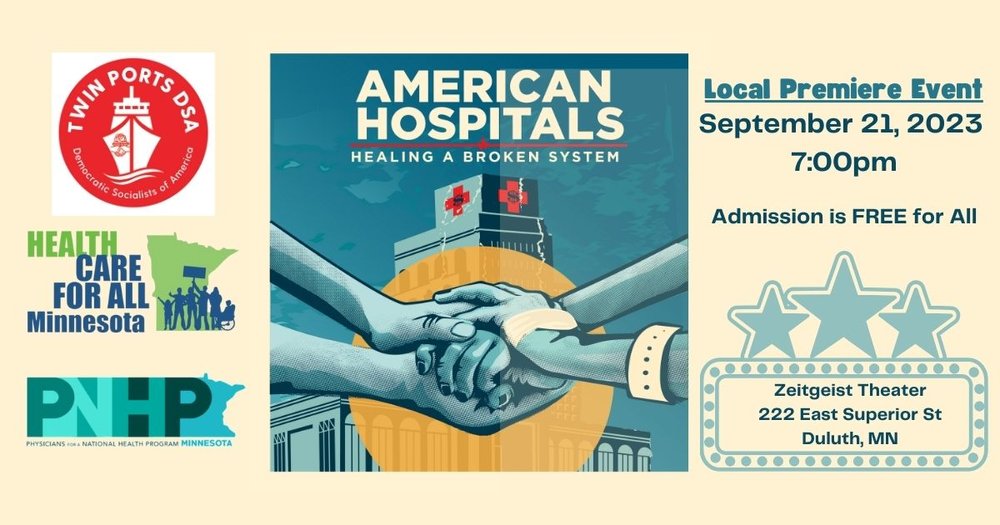
Join us for a free film screening of American Hospitals—Healing a Broken System Thursday, September 21st at 7pm! The film will be followed by a panel discussion led by Dr. Mary Owen.
One of the most striking examples of health disparities in the United States is the unequal distribution of healthcare resources. Health disparities refer to the differences in health outcomes among different groups of people, often based on factors such as race, ethnicity, socioeconomic status, and geographic location.
This film illustrates how corporations have transformed American hospitals into profit maximizers instead of serving to improve the health of the community. American Hospitals will provide valuable insights into this critical issue - and, you will also have the opportunity to connect with others who share your passion for improving access to healthcare for all!
Mark your calendars and join us for an inspiring evening of film and discussion!


Chuck Collins | Altar to an Erupting Sun


Our September Meeting, This Sunday the 10th!
Join us for our monthly meeting and coffee hour! Non-members, both socialist and socialist-curious are encouraged to attend. Our first hour is dedicated to chapter business, with committee reports, updates, announcements, and other chapter news. Then at 5 pm we break for a more free flowing discussion or presentation.
This month, a representative from LEAN (Law Enforcement Accountability Network) will discuss an important case concerning racial justice in our city. Coffee and treats served!



Pride Fest, Pride Parade and The Labor Parade
This was an exhausting weekend. Super hot too. But we made tons of new community connections at the all day Saturday Pride Festival, and our button making station was a big hit. We had a good playlist that we blasted from our PA during the Sunday Pride Parade, and for Labor Day we narrowed it down to three solid labor songs.
View fullsize
View fullsize
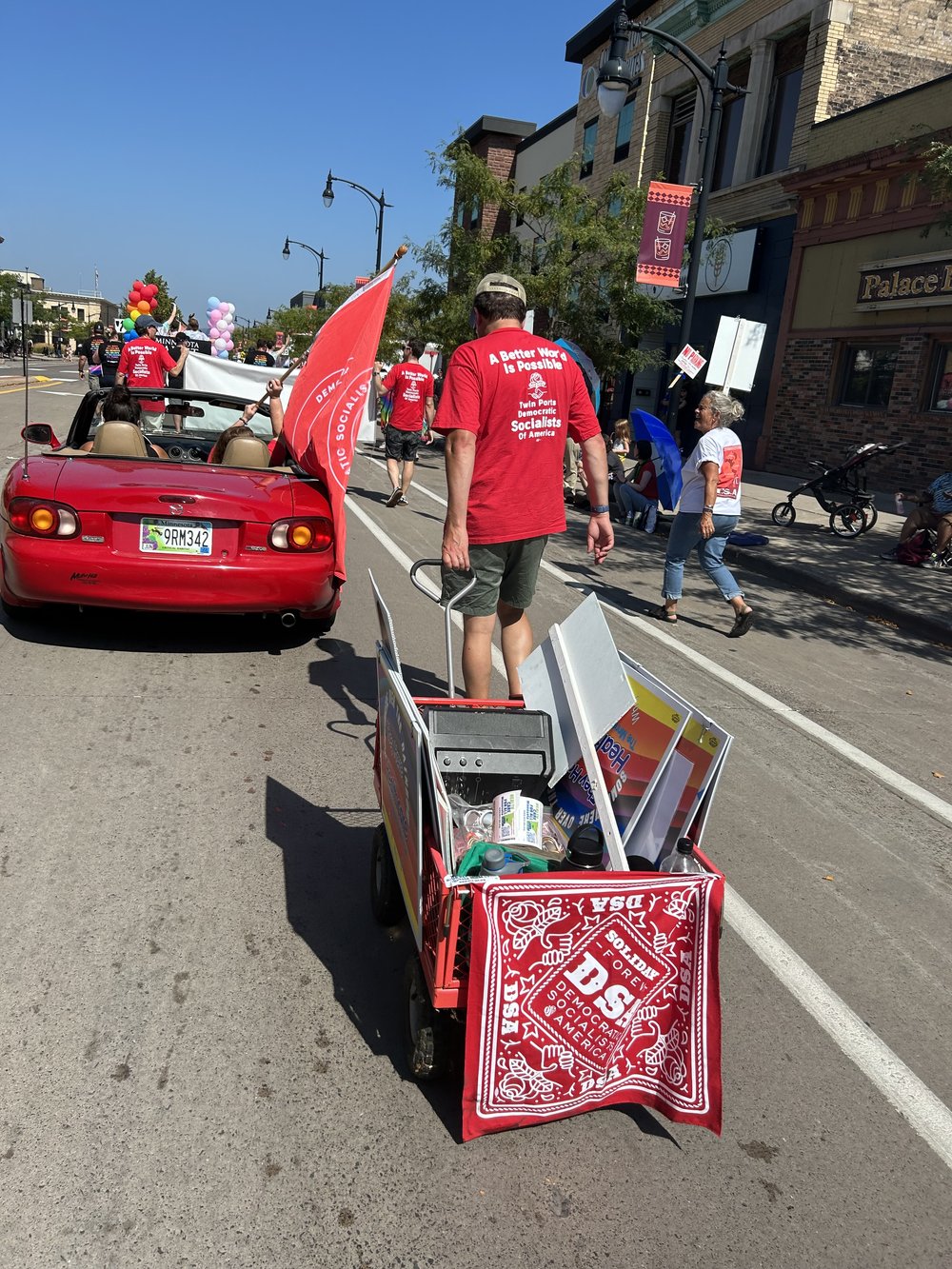
View fullsize
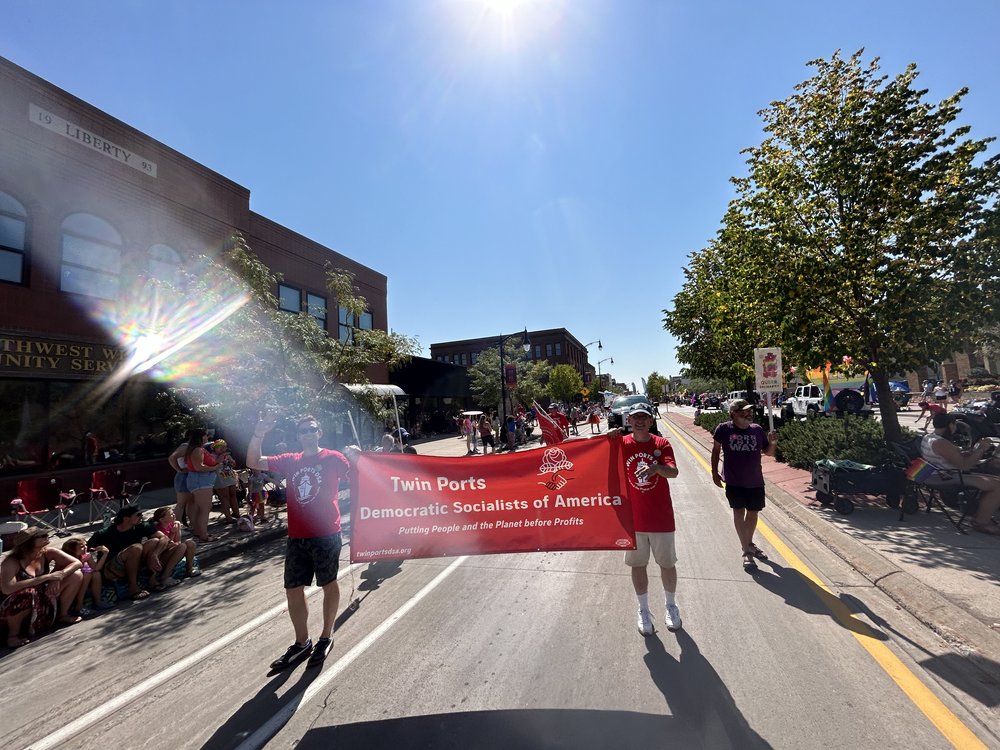
View fullsize
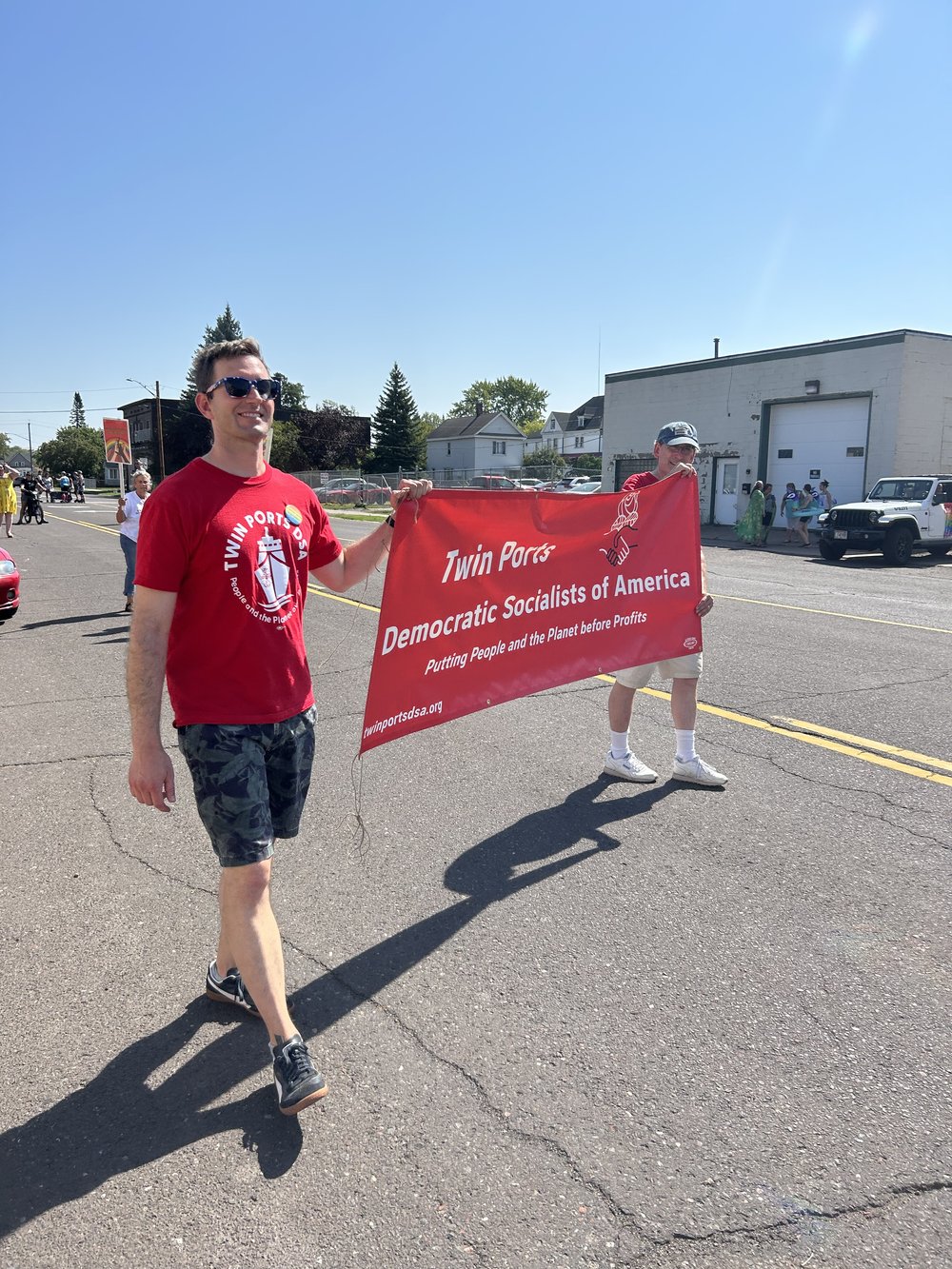
View fullsize

View fullsize

Sarah demonstrates our button making station. People could choose from our designs, or they could draw one of their own (popular with kids).
